
When you learn the Wi-Fi isn’t free, it can be quite a jarring realization, especially in an era where connectivity is often taken for granted. In this digital age, where access to information and communication is only a click away, the expectation of free Wi-Fi has become the norm in many people’s minds. Whether it’s at a café, an airport, or even a hotel, you might assume that just because Wi-Fi is available, it should come at no cost. However, as you dive deeper into the intricacies of how businesses operate in the realm of connectivity, several factors come into play that shed light on why Wi-Fi may not always be free.
First and foremost, let’s examine the economic aspects. Providing Wi-Fi is not a trivial pursuit. Businesses often have to invest significantly in infrastructure, including routers, switches, servers, and the necessary bandwidth to accommodate multiple users. For instance, a small café that hopes to attract customers through the lure of free Wi-Fi must bear the costs associated with maintaining a robust internet connection that can support the demands of its clientele. This includes everything from installation fees to ongoing monthly service charges. Hence, while the end-user may not directly pay for the service, the operational expenses are likely to be reflected in product pricing or added fees elsewhere.
Moreover, beyond simple economics, businesses have to consider the overall customer experience. A slow or unreliable Wi-Fi connection can lead to customer dissatisfaction, and in a competitive environment, businesses cannot afford to risk negative reviews or loss of clientele. Therefore, investing in a reliable Wi-Fi service is often integral to maintaining customer loyalty and providing a conducive environment for patrons. In many cases, the enhancement of customer experience through quality Wi-Fi could very well justify implementing a fee.
On another note, it’s crucial to recognize that many providers view free Wi-Fi as a strategic marketing tactic rather than an outright gift. Offering complimentary Wi-Fi can be a way to draw in potential customers. However, businesses may not always clearly communicate that such services are funded through higher prices on menu items or products. The expectation that Wi-Fi should be free could then conflict with a business model that relies on a different revenue strategy. Furthermore, businesses might utilize free Wi-Fi to gather customer data, either for marketing purposes or to enhance user experience—something that many consumers might not fully grasp.
Another important consideration when discussing why Wi-Fi is not universally free is the quality of service. Free connections are often much slower, and with a higher number of users sharing the bandwidth, the performance can become sluggish. This leads to the emergence of tiered services, where businesses offer a lower-speed connection for free and a higher-speed option for a fee. As users learn to navigate these choices, they may begin to appreciate the factors that determine the quality of their internet experience. Ultimately, most individuals recognize that faster, more reliable connections often come at a premium.
Moreover, security is another pivotal aspect of using public Wi-Fi services. It’s well-known that free Wi-Fi networks can pose risks to personal data. Users accessing their bank accounts or entering sensitive information may find themselves vulnerable if the network is not secure. A realization emerges: paying for Wi-Fi can offer enhanced security measures that protect user data and provide peace of mind. Knowing that a service is provided and managed by a reputable company may allow users to feel more secure than they would on a public network where many variables are unknown.
Additionally, it’s essential to consider the geographical variances in the availability and pricing of Wi-Fi services. In some regions, especially in developing countries, access to the internet can be a luxury, with businesses charging for every bit of bandwidth consumed. Conversely, in urban settings, there might be a competitive landscape where businesses offer free Wi-Fi as a form of advertisement. This disparity highlights the differences in market expectations, availability, and economic conditions, ultimately impacting how consumers view Wi-Fi services.
As you learn about these various elements, it becomes increasingly clear that the notion of free Wi-Fi is not merely a straightforward offer but a complex interplay of economics, marketing, customer experience, security, and regional differences. It is also important to acknowledge that user expectations are rapidly evolving. The demand for seamless connectivity continues to rise, compelling businesses to adapt their models and explore innovative solutions. This flexibility might come in the form of partnerships with internet service providers or unique subscription plans that cater to specific user needs.
Ultimately, when you learn that Wi-Fi isn’t free, it serves as an important reminder of the various layers involved in providing connectivity. Understanding the underlying factors that influence this service allows for a more nuanced perspective on what it means to be connected in today’s world. As consumers, being informed can also foster a greater appreciation for the services we often take for granted. Empowered with this knowledge, we are equipped to navigate the vast landscape of connectivity with a clearer lens, making educated decisions that enrich our online experiences.
In conclusion, while it may initially be disappointing to discover that Wi-Fi isn’t universally free, this realization opens the door to understanding the intricacies and complexities involved in internet connectivity. By recognizing the economic implications, the prioritization of customer experience, the importance of security, and the variations in access across different landscapes, we can develop a more comprehensive understanding of our digital world. Embracing this knowledge allows us to appreciate the services we rely upon daily, enhancing not only our user experience but also our comprehension of the modern business landscape that drives connectivity.


